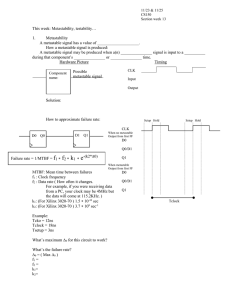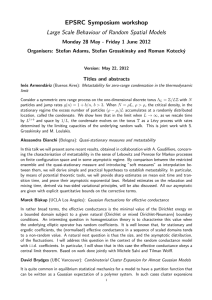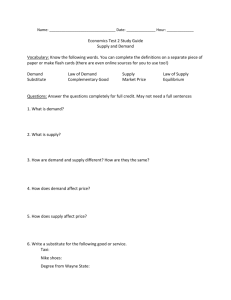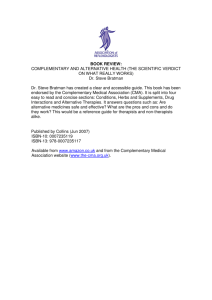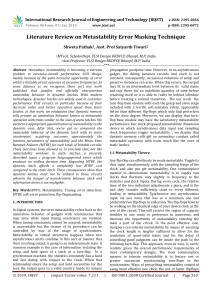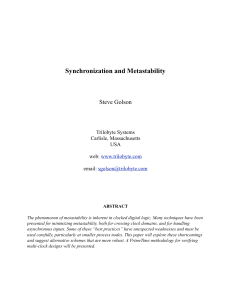Coordination, Complementarity and Understanding
advertisement
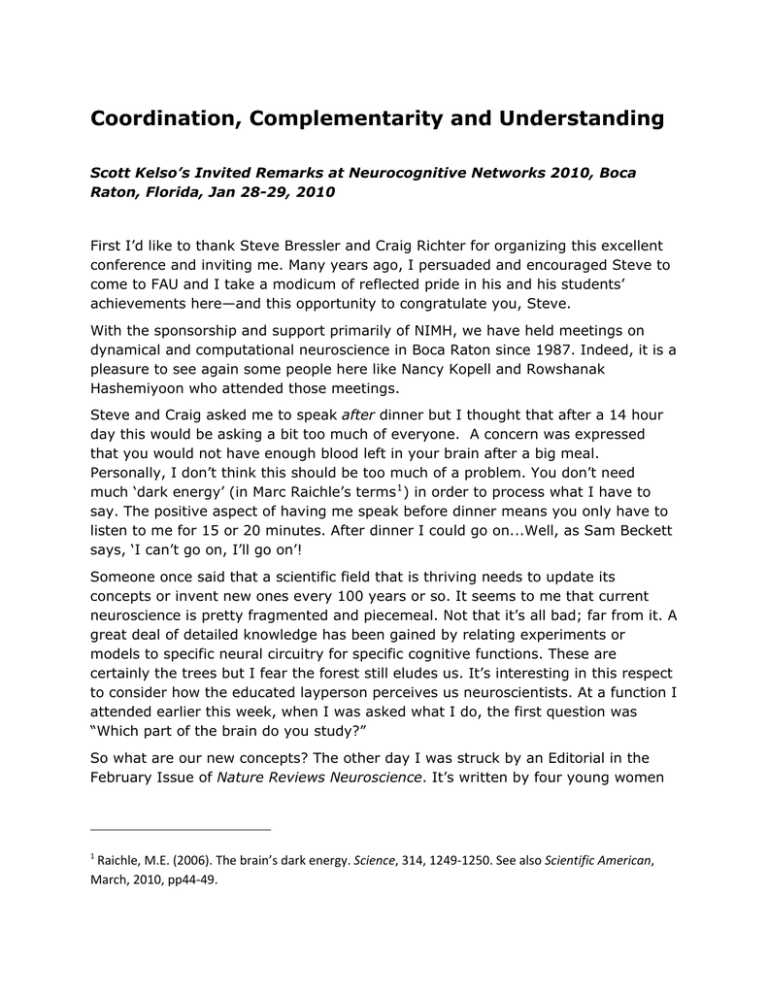
Coordination, Complementarity and Understanding Scott Kelso’s Invited Remarks at Neurocognitive Networks 2010, Boca Raton, Florida, Jan 28-29, 2010 First I’d like to thank Steve Bressler and Craig Richter for organizing this excellent conference and inviting me. Many years ago, I persuaded and encouraged Steve to come to FAU and I take a modicum of reflected pride in his and his students’ achievements here—and this opportunity to congratulate you, Steve. With the sponsorship and support primarily of NIMH, we have held meetings on dynamical and computational neuroscience in Boca Raton since 1987. Indeed, it is a pleasure to see again some people here like Nancy Kopell and Rowshanak Hashemiyoon who attended those meetings. Steve and Craig asked me to speak after dinner but I thought that after a 14 hour day this would be asking a bit too much of everyone. A concern was expressed that you would not have enough blood left in your brain after a big meal. Personally, I don’t think this should be too much of a problem. You don’t need much ‘dark energy’ (in Marc Raichle’s terms 1 ) in order to process what I have to say. The positive aspect of having me speak before dinner means you only have to listen to me for 15 or 20 minutes. After dinner I could go on...Well, as Sam Beckett says, ‘I can’t go on, I’ll go on’! Someone once said that a scientific field that is thriving needs to update its concepts or invent new ones every 100 years or so. It seems to me that current neuroscience is pretty fragmented and piecemeal. Not that it’s all bad; far from it. A great deal of detailed knowledge has been gained by relating experiments or models to specific neural circuitry for specific cognitive functions. These are certainly the trees but I fear the forest still eludes us. It’s interesting in this respect to consider how the educated layperson perceives us neuroscientists. At a function I attended earlier this week, when I was asked what I do, the first question was “Which part of the brain do you study?” So what are our new concepts? The other day I was struck by an Editorial in the February Issue of Nature Reviews Neuroscience. It’s written by four young women 1 Raichle, M.E. (2006). The brain’s dark energy. Science, 314, 1249‐1250. See also Scientific American, March, 2010, pp44‐49. who look as if their combined age is less than a hundred! It’s short, so let me read it to you: In order to maintain proper brain function, neural activity often needs to be tightly coordinated within neuronal ensembles and across different brain regions. In this issue, three articles highlight new concepts that help to explain the functional importance of this coordination and how it is achieved. In recent years, it has been shown that astrocytes, like neurons, are organized into networks. On page 87, Giaume and colleagues discuss the organization of astroglial networks, the rules that govern their intercellular communication through gap junction channels and the effects of such networks on coordinated neuronal activity. Sleep has been shown to be important for the consolidation of memory. In an authoritative Review on page 114, Diekelmann and Born discuss how coordinated patterns of activity in different brain regions during slow wave sleep underlie the re-activation and redistribution of memory traces from the hippocampus to the neocortex. Recently, schizophrenia has been associated with alterations in coordinated oscillatory activity in neurons. In the Review on page 100, Uhlhaas and Singer discuss the mechanisms that could lead to these deficits and how impaired oscillations might contribute to schizophrenia. In summary, these articles highlight the importance of the coordination of neural activity across neuronal networks for brain function. All this talk of neural coordination and its significance reminds one of the prophetic words of the eminent theoretical biologist, Howard Pattee 2 : “I do not see any way to avoid the problem of coordination and still understand the physical basis of life” ! Life is more than DNA. It involves metabolism as well. As Freeman Dyson says, in one of his wonderful reviews in The New York Review, replication is clean, while metabolism is messy. 3 Coordination is a bit like that too. A year or two ago, instead of the word “coordination” or instead of talking about principles of coordination, the buzzword would be “synchronization”. In fact, articles in Science and Nature would mainly be talking about zero-lag synchronization as a means to bind different neuronal activities together. Oscillations (and oscillators) are present at almost every scale of living things and synchrony is certainly a key aspect of coordination in the brain. But it is by no means the only one. Like metabolism with respect to replication, coordination is messier than synchronization. 2 Pattee, H. H. (1976). Physical theories of biological coordination. In Topics in the philosophy of biology, Vol. 27. (M. Grene & E. Mendelsohn, Eds.) Boston: Reidel. 3 Dyson, F. (2007). Working for the revolution. The New York Review (October, 25). For one thing, more and more evidence suggests it is the frequency and phase couplings among the different oscillations in the brain that carries the information about relevant cognitive events. The contents of thought may rely on the activity of particular neural areas but thinking is a dynamic process 4 . Over 30 years ago Francis Crick said… If a breakthrough in the study of the brain does come, it is perhaps likely to be at the level of the overall control of the system. To invent a possible although unlikely example, the discovery that the brain was run phasically…would probably constitute a major breakthrough 5 Crick’s “Astonishing Hypothesis” 6 left many feeling cold—even in S.E. Florida--but in these remarks he may have been closer to the mark than he or anyone else realized. No doubt we’ll hear more about this tomorrow. If you have read the beautiful papers by Olaf Sporns and colleagues on the human connectome 7 , you will see that they conceptualize cognition as a network phenomenon on the basis of two main organizational principles found in the cerebral cortex: functional integration and functional segregation (see also 8 ). But actually, the theory or conceptual framework of coordination that has been developed over the last 25 years or so called coordination dynamics, shows both empirically and theoretically/mathematically that brain and behavior operate in a so-called metastable regime which happens to be a subtle blend of both integrative and segregative tendencies. Thus tendencies for the parts of the brain (and the body) to coordinate together in time coexist with tendencies for the parts of the brain to express their individual autonomy 9 , 10 . It is sometimes said that to be 4 Kelso, J.A.S. (2008). An essay on understanding the mind: The A.S. Iberall Lecture. Ecological Psychology, 20, 180‐208. 5 Crick, F.H.C. (1979). Thinking about the brain. In The Brain. A Scientific American book. New York, W.H. Freeman. 6 Crick, F.H.C. (1994). The Astonishing Hypothesis: The Scientific Search for the Soul. New York, Scribbner. 7 Sporns, O., Tononi, G., & Kotter, R. (2005). The human connectome: A structural description of the human brain. PLoS Computational Biology, 1, e42 8 Tononi, G., Sporns, O., and Edelman, G.M. (1994) A measure for brain complexity: Relating functional segregation and integration in the nervous system. Proc. Natl. Acad. Sci. USA 91, 5033‐5037. 9 Kelso, J.A.S. (1995). Dynamic Patterns: The Self‐Organization of Brain and Behavior. Cambridge, MA: The MIT Press. useful in neuroscience dynamical systems need to consider that the nervous system is extended in space not just in time. But actually metastable coordination—the subtle blend of order and disorder occurs both in space and in time. Let me draw this point out just a little more. The picture of coordination in the brain that is emerging says that functional integration and functional segregation are not dualistic or alternative principles or views of cortical organization. The two apparently opposing processes are actually complementary. That is, the tendency for specialized parts of the brain to express their individual autonomy goes on at the same time as the tendency for the parts to couple together (synaptically, through astroglial support and so forth). The normal operating mode of the brain is not one or the other as people have historically conceived it. So also, one suspects, it is with the two opposing perspectives of the brain either as a primarily reflexive entity driven by the environment or as possessing a complex, intrinsic dynamics. It is neither purely one nor purely the other. The logic is as much both~and and neither~nor as it is either~or. Complementarity you may remember was introduced by Bohr as a means to understand quantum mechanics: Both wave and particle descriptions of nature, of light and matter, are mutually exclusive but equally valid. In 1932 Bohr actually proposed to extend complementarity to biology suggesting that the description of a living creature as an organism and the description of it as a collection of molecules are also complementary. Both are correct but mutually exclusive. However, when Watson and Crick discovered the double helix and proclaimed it as the secret of life, deep ideas about complementarity seemed unnecessary. 50 years later, after we have completely mapped the genomes of humans and other creatures and the processes of replication have been thoroughly understood, deep mysteries remain. Life is more than replication (ref. 2 op.cit.). The new biology sees a living creature from fruit flies to humans as dynamic patterns of organization in the stream of chemicals and energy and information passing through them. 11 Such dynamic patterns are constantly forming and reforming themselves. Trying to observe and localize every molecule as it passes through an organism would likely destroy these 10 Bressler, S.L. & Kelso, J.A.S. (2001) Cortical coordination dynamics and cognition. Trends in Cognitive Sciences, 5, 26‐36. 11 Woese, C.R. (2004). A new biology for a new century. Microbiology and Molecular Biology Reviews (June), 173‐186. patterns that constitute metabolism. In this picture of life, complementarity plays a central role just as Bohr said it should 12 I think that this is what metastable coordination—seen incidentally across the level of cells, brains and behavior—is also telling us. Metastability is a dynamic flow consisting of both phase trapping and phase scattering. It is the simultaneous realization of two competing tendencies, the tendency to couple together and the tendency of the components to remain independent. Metastability is telling us that it’s not just one or the other, but both at the same time. Contraria sunt complementa as Bohr’s famous coat of arms says. Metastability is telling us that there is a deep principle of complementarity underlying how the brain works. Metastability says that complementary aspects and their dynamics are found not just at the remote level of subatomic processes dealt with by quantum mechanics, but at the level of human beings, human brains and human behavior. Understanding the brain would seem to depend on this realization. The word “Neurocognitive” as in Neurocognitive Networks 2010 implies a closing of the gap between the neuro- Matter and the cognitive-Mind. But we all know it’s a slight of hand. Mind and matter, neuro and cognitive retain their dualistic aspects even though we join the words together. But if metastable coordination dynamics does reflect a fundamental complementary nature then there is hope not just of ushering in a novel epistemology but also a complementary neuroscience where neuro and cognitive are seen as complementary 13 . The great physicist Wolfgang Pauli (1955/1994), he of the exclusion principle, probably expressed it best: To us the only acceptable point of view appears to be one that recognizes both sides of reality—the quantitative and the qualitative, the physical and the psychical—as compatible with each other. It would be most satisfactory of all if physics and psyche [matter and mind] could be seen as complementary aspects of the same reality (p.260) 14 . 12 Kelso, J.A.S., & Engstrom, D. A. (2006). The Complementary Nature, Cambridge, MA: The MIT Press. 13 Kelso, J.A.S. & Tognoli, E. (2007) Toward a complementary neuroscience: Metastable coordination dynamics of the brain. In R. Kozma & L. Perlovsky (Eds.) Neurodynamics of Cognition and Consciousness. Springer, Heidelberg, pp. 39‐60. 14 Pauli, W. (1955/1994). The influence of archetypal ideas on the scientific theories of Kepler. In C.P. Enz & K. von Meyenn (eds.), Writings on physics and philosophy. Berlin, Springer‐Verlag. Thinking in terms of contraries and the either/or is easy when things are simple. But in complex coordinated systems sharp dichotomies and contrarieties will have to be replaced with far more subtle and sophisticated complementarities. For all of nature, human nature (and human brains) included. Let me leave you with that thought along with my best wishes for an enjoyable dinner. Why might metastability be a useful design principle for the coordination of the brain and what kind of advantages might it confer upon neurocognitive models? First, metastability accommodates heterogeneous elements (e.g. brain areas having disparate intrinsic dynamics; brain areas whose activity is associated with the movement of body parts or events in the environment). Second, metastability does not require a disengagement mechanism as when the system is in an attractor and has to switch to another state. This can be costly in terms of time, energy and information processing. In the metastable mode, neither stochastic noise nor parameter changes are necessary for the system to explore its patternings. Third, metastability allows the nervous system to flexibly browse through a set of possibilities (tendencies of the system) rather than adopting a single ‘point of view’. Fourth, metastability is an expression of the full complexity of the brain. Thus, If a connection between theoretical/computational modeling and empirical research can be strongly established it will go a long way to establishing metastability as a key property of the brain’s coordination dynamics and a key design principle.
